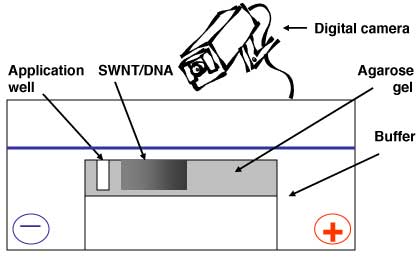| Posted: Aug 21, 2006 | |
The challenge of separating and sorting carbon nanotubes after production |
|
| (Nanowerk Spotlight) Current production methods for carbon nanotubes result in units with different diameter, length, chirality and electronic properties, all packed together in bundles, and often blended with some amount of amorphous carbon. The separation of nanotubes according to desired properties remains a technical challenge. Especially single-walled carbon nanotube (SWCNT) sorting is a challenge because the composition and chemical properties of SWCNTs of different types are very similar, making conventional separation techniques inefficient. | |
| The separation techniques for SWCNTs explored to date rely on preferential electron transfer on metallic SWCNTs treated with diazonium salts, dielectrophoresis, enhanced chemical affinity of semiconducting SWCNTs with octadecylamine, and wrapping of SWCNTs with single-stranded DNA. The selectivity of these methods can be further enhanced by vigorous centrifugation of prepared dispersions and the use of ion-exchange chromatography. | |
| An electrophoretic approach to SWCNT sorting has been proposed by researchers at the University of Texas at Dallas (UTD). They showed that nanotubes with different spectroscopic properties possess different electrophoretic mobilities. | |
| Dr. Alexandre Vetcher, currently working in National Center for Biodefense and Infectious Diseases at George Mason University, explains the new technique to Nanowerk: "We demonstrated that aqueous SWCNT dispersions, prepared with the aid of nucleic acids (RNA or DNA), can separate into fractions using agarose gel electrophoresis. The SWCNTs moved in the direction of positive potential to form well-defined bands. Raman spectroscopy as a function of band position showed that nanotubes having different spectroscopic properties possess different electrophoretic mobilities." | |
| Parallel elution of the SWCNT/DNA and SWCNT/RNA complexes from the gel during electrophoresis and subsequent characterization by atomic force microscope revealed differences in nanotube diameter, length and curvature. | |
 |
|
| Diagram of the electrophoretic scheme. The direction of SWCNT/NA separation is indicated by the large arrow. (Source: University of Texas) | |
| Vetcher and colleagues from the UTD's Nanotech Institute as well as the Department of Chemistry reported their findings in a recent paper, titled "Fractionation of SWCNT/nucleic acid complexes by agarose gel electrophoresis", published in the August 7, 2006 online edition of Nanotechnology. | |
| "The exciting feature of this technology is that the SWCNT fractionation on the gel can be seen by the naked eye and quantified using simple spectroscopic tools" says Vetcher. "It can therefore be employed as an analytical technique for evaluating composition and homogeneity of nanotube dispersions." | |
| The researchers also state that beyond a role in characterizing SWCNT dispersions, agarose gel electrophoresis is a potential method for purifying SWCNT/NA complexes on the basis of physical properties. | |
| "We also see the possibility of RNA replacement with other bio-polymers to obtain novel bio-nano complexes needed for bio-sensing applications" adds Vetcher. "The possibility of simple RNA replacement with biologically unrelated surfactants in water-based solution opens a new door to manipulation with SWNTs after their debundling". | |
| Targeted applications of semiconducting nanotubes that can be produced by this method include transistors, nanotube-based light emitting devices, sensors, etc. | |
| Watch a time-lapse movie (one frame per 10 second) of electrohoresis of SWNT/DNA dispersion that migrates in agarose gel from well area (dark) in the direction of positive potential. Fractionation of nanotubes was achieved by this procedure. | |
 By
Michael
Berger
– Michael is author of three books by the Royal Society of Chemistry:
Nano-Society: Pushing the Boundaries of Technology,
Nanotechnology: The Future is Tiny, and
Nanoengineering: The Skills and Tools Making Technology Invisible
Copyright ©
Nanowerk LLC
By
Michael
Berger
– Michael is author of three books by the Royal Society of Chemistry:
Nano-Society: Pushing the Boundaries of Technology,
Nanotechnology: The Future is Tiny, and
Nanoengineering: The Skills and Tools Making Technology Invisible
Copyright ©
Nanowerk LLC
|
|
Become a Spotlight guest author! Join our large and growing group of guest contributors. Have you just published a scientific paper or have other exciting developments to share with the nanotechnology community? Here is how to publish on nanowerk.com.
